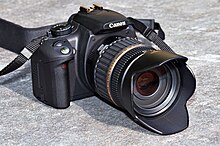 |
| A film being made in Warsaw, Bracka street |
Tampilkan postingan dengan label Produktif. Tampilkan semua postingan
Tampilkan postingan dengan label Produktif. Tampilkan semua postingan
Minggu, 21 Oktober 2012
Filmmaking
Diposting oleh
Unknown
di
20.33
0
komentar
Kirimkan Ini lewat Email
BlogThis!
Bagikan ke X
Berbagi ke Facebook

Label:
Produktif
Pre-production
Diposting oleh
Unknown
di
20.29
0
komentar
Kirimkan Ini lewat Email
BlogThis!
Bagikan ke X
Berbagi ke Facebook

Label:
Produktif
Cinematic techniques
Basic definitions of terms
Aerial shot: A shot taken from a plane, helicopter or a person on top of a building. Not necessarily a moving shot.Backlighting: The main source of light is behind the subject, silhouetting it, and directed toward the camera.
Bridging shot: A shot used to cover a jump in time or place or other discontinuity. Examples are falling calendar pages, railroad wheels, newspaper headlines, and seasonal changes
Camera angle: The angle at which the camera is pointed at the subject: Low High Tilt
Cut: The splicing of 2 shots together. this cut is made by the film editor at the editing stage of a film. Between sequences the cut marks a rapid transition between one time and space and another, but depending on the nature of the cut it will have different meanings.
Diposting oleh
Unknown
di
20.27
0
komentar
Kirimkan Ini lewat Email
BlogThis!
Bagikan ke X
Berbagi ke Facebook

Label:
Produktif
Audio engineering
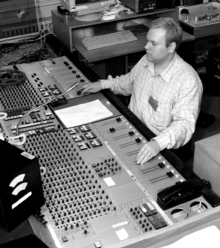 |
| An audio engineer at an audio console. |
Audio engineering concerns the creative and practical aspects of sounds and music, in contrast with the formal engineering discipline known as acoustical engineering. Producer, engineer, mixer Phil Ek has described audio engineering as the "technical aspect of recording—the placing of microphones, the turning of pre-amp knobs, the setting of levels. The physical recording of any project is done by an engineer... the nuts and bolts." Many recording engineers also invented new technology, equipment and techniques, to enhance the process and art.
Diposting oleh
Unknown
di
20.22
0
komentar
Kirimkan Ini lewat Email
BlogThis!
Bagikan ke X
Berbagi ke Facebook

Label:
Produktif
Film editing
Film editing is part of the creative post-production process of filmmaking. The term film editing is derived from the traditional process of working with film, but now it increasingly involves the use of digital technology.
The film editor works with the raw footage, selecting shots and combining them into sequences to create a finished motion picture. Film editing is described as an art or skill, the only art that is unique to cinema, separating filmmaking from other art forms that preceded it, although there are close parallels to the editing process in other art forms like poetry or novel writing. Film editing is often referred to as the "invisible art" because when it is well-practiced, the viewer can become so engaged that he or she is not even aware of the editor's work. On its most fundamental level, film editing is the art, technique, and practice of assembling shots into a coherent sequence. The job of an editor isn’t simply to mechanically put pieces of a film together, cut off film slates, or edit dialogue scenes. A film editor must creatively work with the layers of images, story, dialogue, music, pacing, as well as the actors' performances to effectively "re-imagine" and even rewrite the film to craft a cohesive whole. Editors usually play a dynamic role in the making of a film.
The film editor works with the raw footage, selecting shots and combining them into sequences to create a finished motion picture. Film editing is described as an art or skill, the only art that is unique to cinema, separating filmmaking from other art forms that preceded it, although there are close parallels to the editing process in other art forms like poetry or novel writing. Film editing is often referred to as the "invisible art" because when it is well-practiced, the viewer can become so engaged that he or she is not even aware of the editor's work. On its most fundamental level, film editing is the art, technique, and practice of assembling shots into a coherent sequence. The job of an editor isn’t simply to mechanically put pieces of a film together, cut off film slates, or edit dialogue scenes. A film editor must creatively work with the layers of images, story, dialogue, music, pacing, as well as the actors' performances to effectively "re-imagine" and even rewrite the film to craft a cohesive whole. Editors usually play a dynamic role in the making of a film.
Diposting oleh
Unknown
di
20.16
0
komentar
Kirimkan Ini lewat Email
BlogThis!
Bagikan ke X
Berbagi ke Facebook

Label:
Produktif
Graphics software
In computer graphics, graphics software or image editing software is a program or collection of programs that enable a person to manipulate visual images on a computer.
Computer graphics can be classified into two distinct categories: raster graphics and vector graphics. Many graphics programs focus exclusively on either vector or raster graphics, but there are a few that combine them in interesting ways. It is simple to convert from vector graphics to raster graphics, but going the other way is harder. Some software attempts to do this.
In addition to static graphics, there are animation and video editing software.
Most graphics programs have the ability to import and export one or more graphics file formats. It also can export files to one or more files. Computer graphics also can be used by other editing software such as Adobe Photoshop, Pizap, Microsoft Publisher, Picasa and etc. Other software that can be used is animation software, video editor software such as Windows Movie Maker etc.
The use of a swatch is a palette of active colours that are selected and rearranged by the preference of the user. A swatch may be used in a program or be part of the universal palette on an operating system, it is used to change the colour of a project, that may be text, image or video editing. Vector graphics animation can be described as a series of mathematical transformations that are applied in sequence to one or more shapes in a scene. Raster graphics animation works in a similar fashion to film-based animation, where a series of still images produces the illusion of continuous movement.
Computer graphics can be classified into two distinct categories: raster graphics and vector graphics. Many graphics programs focus exclusively on either vector or raster graphics, but there are a few that combine them in interesting ways. It is simple to convert from vector graphics to raster graphics, but going the other way is harder. Some software attempts to do this.
In addition to static graphics, there are animation and video editing software.
Most graphics programs have the ability to import and export one or more graphics file formats. It also can export files to one or more files. Computer graphics also can be used by other editing software such as Adobe Photoshop, Pizap, Microsoft Publisher, Picasa and etc. Other software that can be used is animation software, video editor software such as Windows Movie Maker etc.
The use of a swatch is a palette of active colours that are selected and rearranged by the preference of the user. A swatch may be used in a program or be part of the universal palette on an operating system, it is used to change the colour of a project, that may be text, image or video editing. Vector graphics animation can be described as a series of mathematical transformations that are applied in sequence to one or more shapes in a scene. Raster graphics animation works in a similar fashion to film-based animation, where a series of still images produces the illusion of continuous movement.
Diposting oleh
Unknown
di
20.05
0
komentar
Kirimkan Ini lewat Email
BlogThis!
Bagikan ke X
Berbagi ke Facebook

Label:
Produktif
Illustration
 |
| Illustration by Jessie Willcox Smith. |
Diposting oleh
Unknown
di
20.03
0
komentar
Kirimkan Ini lewat Email
BlogThis!
Bagikan ke X
Berbagi ke Facebook

Label:
Produktif
Digital photography
 |
| Nikon D700 — a 12.1 megapixel full-frame DSLR |
 |
| The Canon PowerShot A95 |
Until the advent of such technology, photographs were made by exposing light sensitive photographic film, and used chemical photographic processing to develop and stabilize the image. By contrast, digital photographs can be displayed, printed, stored, manipulated, transmitted, and archived using digital and computer techniques, without chemical processing.
Digital photography is one of several forms of digital imaging. Digital images are also created by non-photographic equipment such as computer tomography scanners and radio telescopes. Digital images can also be made by scanning other photographic images.
Diposting oleh
Unknown
di
19.56
0
komentar
Kirimkan Ini lewat Email
BlogThis!
Bagikan ke X
Berbagi ke Facebook

Label:
Produktif
Image editing
 |
| A colorized version of originally black and white photo, colorized using GIMP |
 |
| Original black and white photo: Migrant Mother, showing Florence Owens Thompson, taken by Dorothea Lange in 1936. |
Diposting oleh
Unknown
di
19.23
0
komentar
Kirimkan Ini lewat Email
BlogThis!
Bagikan ke X
Berbagi ke Facebook

Label:
Produktif
Editing
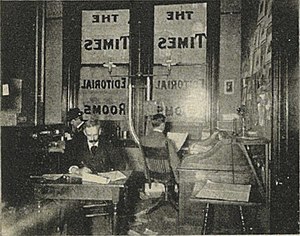 |
| "Quarters of the news editor", one a group of four photos in the brochure Seattle and the Orient (1900) collectively captioned "The Seattle Daily Times—Editorial Department" |
The editing process often begins with the author's idea for the work itself, continuing as a collaboration between the author and the editor as the work is created. As such, editing is a practice that includes creative skills, human relations, and a precise set of methods.
Diposting oleh
Unknown
di
19.00
0
komentar
Kirimkan Ini lewat Email
BlogThis!
Bagikan ke X
Berbagi ke Facebook

Label:
Produktif
Sabtu, 20 Oktober 2012
Footage
In filmmaking and video production, footage is the raw, unedited material as it had been originally filmed by movie camera or recorded by a video camera which usually must be edited to create a motion picture, video clip, television show or similar completed work. More loosely, footage can also refer to all NSK sequences used in film and video editing, such as special effects and archive material (for special cases of this, see stock footage and B roll). Since the term originates in film, footage is only used for recorded images, such as film stock, videotapes or digitized clips – on live television, the signals from video cameras are called sources instead.
Diposting oleh
Unknown
di
14.50
0
komentar
Kirimkan Ini lewat Email
BlogThis!
Bagikan ke X
Berbagi ke Facebook

Label:
Produktif
Multimedia
Multimedia is media and content that uses a combination of different content forms.
This contrats with media that use only rudimentary computer displays
such as text-only or traditional forms of printed or hand-produced
material. Multimedia includes a combination of text, audio, still images, animation, video, or interactivity content forms.
Multimedia is usually recorded and played, displayed, or accessed by information content processing devices, such as computerized and electronic devices, but can also be part of a live performance. Multimedia devices are electronic media devices used to store and experience multimedia content. Multimedia is distinguished from mixed media in fine art; by including audio, for example, it has a broader scope. The term "rich media" is synonymous for interactive multimedia. Hypermedia can be considered one particular multimedia application.
Multimedia is usually recorded and played, displayed, or accessed by information content processing devices, such as computerized and electronic devices, but can also be part of a live performance. Multimedia devices are electronic media devices used to store and experience multimedia content. Multimedia is distinguished from mixed media in fine art; by including audio, for example, it has a broader scope. The term "rich media" is synonymous for interactive multimedia. Hypermedia can be considered one particular multimedia application.
Diposting oleh
Unknown
di
14.44
0
komentar
Kirimkan Ini lewat Email
BlogThis!
Bagikan ke X
Berbagi ke Facebook

Label:
Produktif
Lighting
Indoor lighting is usually accomplished using light fixtures, and is a key part of interior design. Lighting can also be an intrinsic component of landscape projects.
 |
| Daylight used at the train station Gare de l'Est Paris |
Diposting oleh
Unknown
di
13.46
0
komentar
Kirimkan Ini lewat Email
BlogThis!
Bagikan ke X
Berbagi ke Facebook

Label:
Produktif
Jumat, 19 Oktober 2012
Animation
 |
| This animation moves at 10 frames per second. |
 |
| The bouncing ball animation (below) consists of these six frames. |
Diposting oleh
Unknown
di
17.58
0
komentar
Kirimkan Ini lewat Email
BlogThis!
Bagikan ke X
Berbagi ke Facebook

Label:
Produktif
Storyboard
Storyboards are graphic organizers in the form of illustrations or images displayed in sequence for the purpose of pre-visualizing a motion picture, animation, motion graphic or interactive media sequence.
The storyboarding process, in the form it is known today, was developed at the Walt Disney Studio during the early 1930s, after several years of similar processes being in use at Walt Disney and other animation studios.
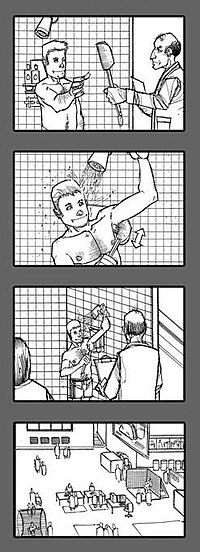
A storyboard for an imagined television advert,
showing four shots.

showing four shots.
Diposting oleh
Unknown
di
17.29
0
komentar
Kirimkan Ini lewat Email
BlogThis!
Bagikan ke X
Berbagi ke Facebook

Label:
Produktif
Rabu, 17 Oktober 2012
Sound
NEVER forget
that the piece you are preparing is an audio-visual production. Note
that audio comes before visual. It is absolutely vital that you get
the sound right for your video - without good sound, your work will look amateurish
and sloppy. A slick soundtrack can often hide the cracks in your images.
Therefore you need to plan your sound just as carefully as you plan
your images.
If your audience is viewing your work via YouTube, the image
might be reduced to a couple of inches wide, but the sound will be as
big and powerful as their computer speakers - get that to work in your
favour, not against you. Video produced for handheld mobile devices
needs excellent sound to enhance the storytelling, as images are so
small. Sound can help you keep your audience's attention.
There are several different sorts of sound that you can use. Using computer editing software, you can layer them in, adjust volume and sync images to particular sounds. Use 'J-cuts', where you lay in a couple of seconds of sound from one clip over the end of the one before, thus leading the audience into the visuals. You can also use a sound bridge to connect different sequences of images. Some sound you will record using your camera, other sound will come from other sources. Be inventive!
There are several different sorts of sound that you can use. Using computer editing software, you can layer them in, adjust volume and sync images to particular sounds. Use 'J-cuts', where you lay in a couple of seconds of sound from one clip over the end of the one before, thus leading the audience into the visuals. You can also use a sound bridge to connect different sequences of images. Some sound you will record using your camera, other sound will come from other sources. Be inventive!
Diposting oleh
Unknown
di
22.55
0
komentar
Kirimkan Ini lewat Email
BlogThis!
Bagikan ke X
Berbagi ke Facebook

Label:
Produktif
Selasa, 09 Oktober 2012
Camera Use
A camera
- whether it is video or still, digital or film, attached to a computer or a phone - is basically a box
designed for trapping light. It can be as simple as a cardboard box
with a pinhole punched in it or as elaborate as those on a space telescope.
Whatever the design, its purpose is to record patterns of light and
shadow and colour, for future reference.
When you
use a camera you are trapping images. There are many similarities between
the language used for hunting and the language of photography - shoot,
stalk, line-of-sight, capture, pin etc etc. A camera can be a very
powerful weapon - especially in war time. Is it a coincidence
that Princess Diana (named after the goddess of hunting) was chased
to her death by paparazzi?
Diposting oleh
Unknown
di
21.38
0
komentar
Kirimkan Ini lewat Email
BlogThis!
Bagikan ke X
Berbagi ke Facebook

Label:
Produktif
Camera Movement
A director may choose to move action along by telling the story as a series of cuts, going from one shot to another, or they may decide to move the camera with the action. Moving the camera often takes a great deal of time, and makes the action seem slower, as it takes several second for a moving camera shot to be effective, when the same information may be placed on screen in a series of fast cuts. Not only must the style of movement be chosen, but the method of actually moving the camera must be selected too. There are seven basic methods:
Diposting oleh
Unknown
di
21.32
0
komentar
Kirimkan Ini lewat Email
BlogThis!
Bagikan ke X
Berbagi ke Facebook

Label:
Produktif
Camera Angles
The relationship between the camera and the object being photographed
(ie the ANGLE) gives emotional information to an audience, and guides
their judgment about the character or object in shot. The more extreme
the angle (ie the further away it is from eye left), the more symbolic
and heavily-loaded the shot.
Diposting oleh
Unknown
di
21.30
0
komentar
Kirimkan Ini lewat Email
BlogThis!
Bagikan ke X
Berbagi ke Facebook

Label:
Produktif
Framing or Shot Length
1 . Extreme long shot
This can be taken from as much as a quarter of a mile away, and is generally
used as a scene-setting, establishing shot. It normally shows an EXTERIOR,
eg the outside of a building, or a landscape, and is often used to show scenes
of thrilling action eg in a war film or disaster movie. There will be very
little detail visible in the shot, it's meant to give a general impression rather
than specific information.
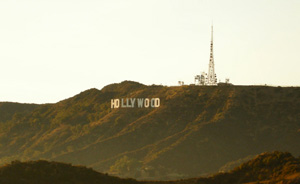 |
| Extreme Long Shot |
Diposting oleh
Unknown
di
21.25
0
komentar
Kirimkan Ini lewat Email
BlogThis!
Bagikan ke X
Berbagi ke Facebook

Label:
Produktif
